




By Julie Slama | j.slama@mycityjournals.com
New state and federal rules, fresh local produce and student taste tests are shaping what is served on the meal trays across Jordan District schools.
Seven weeks before 57,000 Jordan School District students return to school, Jordan’s Director of Nutrition Services Katie Bastian is already deep into planning breakfasts and lunches, placing food orders and prepping staff to guide kindergartners through cafeteria lines.
“Food is what we do; I have a team of more than 500 staff members to get it done,” Bastian said.
Jordan, Utah’s fourth-largest school district, serves about 35,000 meals daily across 64 schools during the school year, plus up to 1,000 during summer lunch programs. Meals comply with the Healthy, Hunger-Free Kids Act of 2010, which sets limits on calories, so-
dium, fat and sugar while emphasizing fruits, vegetables, whole grains and low-fat dairy.
Bastian said students typically choose from five components: meat or a substitute, grain, fruit, vegetable and (fluid) milk. She follows USDA standards, which continue to evolve.
“Most children, like most Americans, are consuming too much added sugars and sodium and not enough fruits, vegetables and whole grains,” Bastian said. “We always want to make the food as delicious and appealing as possible.”
This fall marks the start of a gradual USDA rollout reducing added sugars and sodium through 2027. At the same time, Utah passed HB402 banning synthetic food dyes in schools by 2026–27.
“A lot of our K-12 specific food items don’t have a lot of dyes in them,” she said,
Continued page 4







For many, chronic pain is a relentless companion, impacting every facet of daily life. But hope is on the horizon. Breakthroughs in pain management being used at CommonSpirit hospitals are offering new avenues for relief, moving beyond traditional methods to provide more targeted and effective solutions.
Chronic lower back pain is one of the most common challenges. One of the most promising advancements for managing chronic low back pain, particularly for individuals suffering from vertebrogenic pain, is radiofrequency ablation (sometimes referred to as Intracept). This minimally invasive treatment is designed to provide long-lasting relief and improve overall quality of life by addressing the source of the pain, rather than simply masking the symptoms. In this procedure, a small probe is inserted through a tiny incision and guided to the basivertebral nerve and then radiofrequency ablation is used to disrupt the nerve’s ability to transmit pain signals.
“Radiofrequency ablation represents a significant shift in how we approach chronic lower back pain,” explains Dr. Snigdha Ancha, a leading pain management specialist. “By directly targeting the nerve responsible for transmitting pain, we can provide lasting relief for patients who haven’t found success with other treatments.”
But what makes radiofrequency ablation
so effective? Traditional pain management often relies on medications, physical therapy, or injections, which can provide temporary relief but don’t always address the underlying cause. Intracept, on the other hand, offers a more permanent solution by disrupting the pain pathway. Studies have shown significant reductions in pain scores and improved function in patients who have undergone the procedure.
Beyond radiofrequency ablation, other innovative techniques are gaining traction. Neuromodulation therapies, such as spinal cord stimulation (SCS), are becoming increasingly sophisticated. These devices deliver mild electrical impulses to the spinal cord, interrupting pain signals before they reach the brain. Newer SCS systems are designed to be more comfortable and customizable, allowing for personalized pain relief.



“We’re seeing remarkable results with neuromodulation,” says Dr. Jeffrey Pence, a pioneer in pain management technology. “The ability to fine-tune the stimulation to match each patient’s unique pain pattern is a game-changer. It’s not just about reducing pain; it’s about restoring quality of life.”
In addition to these advanced procedures, a holistic approach to pain management is crucial. This includes:
• Physical Therapy: Strengthening muscles, improving flexibility, and restoring function
• Cognitive Behavioral Therapy (CBT): Helping patients manage pain through coping strategies and behavioral changes
• Mindfulness and Meditation: Reducing stress and improving pain tolerance
It’s important to remember that pain management is not a one-size-fits-all solution. The best approach is tailored to each individual’s specific needs and circumstances. A comprehensive evaluation by a qualified pain management specialist is essential to determine the most appropriate treatment plan.
If you’re living with chronic pain, don’t lose hope. The advancements in pain management are offering new possibilities for relief and a chance to reclaim your life. Talk to your doctor about the latest techniques and find a path that works for you.

Learn more about the services, care providers and missiondriven work of the Holy Cross hospitals and CommonSpirit Health at www.holycrossutah.org.

At CommonSpirit Health, we make the healing presence of God known in our world by improving the health of the people we serve, especially those who are vulnerable, while we advance social justice for all.
When minutes count, count on our emergency care. Get to know us before you need us.
When you need emergency care fast, the closest emergency room is a smart thing to know. You never know the level of care you’ll need when an emergency happens and choosing the right ER can make all the difference. And a hospital ER comes with the confidence of additional services right on-site.
Congratulations to CommonSpirit Holy Cross Hospital – Jordan Valley for receiving the Leapfrog Hospital Safety Grade-A Accreditation for the fourth consecutive time. Leapfrog Hospital Safety Grades are determined based on a rigorous assessment of various safety measures.
Find emergency care close to you at mountain.commonspirit.org. CommonSpirit Health Mountain Region does not discriminate against any person on the basis of race, color, national origin, disability, age, sex, religion, creed, ancestry, sexual orientation, and
admission, treatment, or participation in its programs, services and activities, or in employment. For further information about this policy contact CommonSpirit Health Mountain Region Office of the General Counsel at 1-303-673-8166 (TTY: 711). Copyright © CommonSpirit Health Mountain Region, 2025. ATENCIÓN: Si habla español, tiene a su disposición servicios gratuitos de asistencia lingüística. Llame al 1-303-673-8166 (TTY: 711). CHÚ Ý:
i số 1-303-673-8166 (TTY: 711).
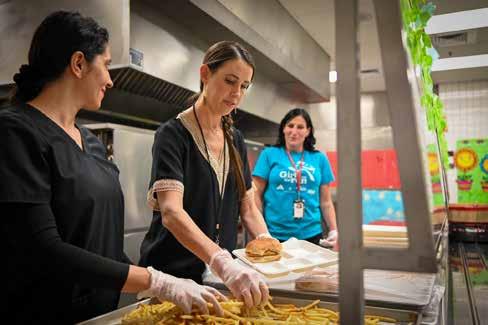

Continued from front page
but the district is reviewing cereals, Jell-O, sprinkles and other products.
Bastian is also educating families on HB100, which eliminates reduced-price meals — now all students who qualify get them for free.
“It is definitely a juggling act. You would think feeding kids wouldn’t be as complicated as it is, but I have a staff of about nine here in my office who help,” she said.
Elementary schools’ menus, which follow daily and weekly nutrition targets, offer two choices daily; secondary students have 25 or more. There also are vegetarian and allergy-sensitive meals.
“They’ll have the main line, then three or four different hot sandwiches, four different varieties of pizza, three different kinds of salad, mini corn dogs and more,” she said. Food ordering is districtwide and based
on prior year participation. Bastian uses USDA commodities and works with approved processors to buy in bulk. She purchases several hundred thousand pounds of chicken, beef or pork as well as about 1.2 million pounds of potatoes.
“We try and bring pretty much all high usage items into our warehouse to save money, except for fries; we go through a lot of fries,” she said.
Elementary menus run on six-week cycles, secondary on four. Menu committees replace unpopular meals such as Shepherd’s Pie and introduce new recipes, some of which are requested by families. When they had leftover hash browns, the team created a cheesy potato dish.
“The kids loved it and our staff is skilled enough to try new recipes,” Bastian said. “We make as much as we can from scratch.”
That includes bread items, lasagna,
mac and cheese and soup made in the school kitchens.
Even kid-favorites such as corn dogs are made healthier.
“Our corn dogs are low fat, low salt, the dog in the middle is chicken,” she said.
Student feedback plays a role, too. Dietitian interns conduct taste tests with students, guiding menu additions including Asian-inspired dishes.
“We try to offer what they like as well as balancing what’s healthy for them,” Bastian said.
She also coordinates with JATC South students, who supply fresh cucumbers, tomatoes and lettuce for the salad bars in the summer, and with local farmers during the school year to provide apples for Apple Crunch Day and peaches for a Peach Day. She further offers fun meals for students from diverse cuisines for multicultural days to Take Me Out to the Ball Game Day,
with hamburgers, hot dogs and a sampling of root beer.
“There has definitely been changes in nutrition services,” Bastian said, now in her third year as director after 14 as a dietitian and recently was a speaker at the state’s 4th Annual Food Safety Conference. “We’re trying to focus on more fruits and vegetables and the connection of making healthy choices when they’re kids, which will follow them throughout their lives.”
She believes school meals have shed their bad reputation.
“The school lunch stigma that the food is gross doesn’t hold true anymore,” Bastian said. “The cafeteria is a welcoming place, with healthy, delicious food which gives students the energy they need and it’s a social time with your friends. I want it to be one of the best parts of their day.” l
The South Jordan Journal is a monthly publication distributed directly to residents via the USPS as well as locations throughout South Jordan.
For information about distribution please email hello@thecityjournals.com or call our offices. Rack locations are also available on our website. The views and opinions expressed in display advertisements do not necessarily reflect or represent the views and opinions held by Loyal Perch Media or the City Journals. This publication may not be reproduced in whole or in part without the express written consent of the owner. © 2019 Loyal Perch Media, Inc.
Bryan Scott | bryan.s@thecityjournals.com
EDITOR
Travis Barton | travis.b@thecityjournals.com
ADVERTISING EXECUTIVES
Mieka Sawatzki | mieka.s@thecityjournals.com
Lindsay Andreasen | lindsay.a@thecityjournals.com
Jason Corbridge | jason.c@thecityjournals.com
Ryan Casper | ryan.c@thecityjournals.com
Marc Davis | marc.d@thecityjournals.com
Lydia Rice | lydia.r@thecityjournals.com 385-557-1022
Rack
South 500 West, Suite 205 Sandy, UT 84070
PHONE: 801-254-5974































The customary concessions can be found inside the ballpark, but other restaurant options are coming to the area.
By Julie Slama j.slama@mycityjournals.com
There’s a fantastic lineup of restaurants opening at America First Square in Downtown Daybreak. The Salt Lake Bees’ stadium already has the customary concessions, plus Chicken Cantina, Dugout Pizza, Bumble’s BBQ and Smith’s Ballpark Market. It also has current favorites Swig, J Dawgs and a Chick-fil-A food truck for those wanting to eat inside the stadium. Those eagerly expecting the new restaurants will be glad to know that 2 of them will be opening soon.
“Moena Café was started 13 years ago in Hawaii as a small boutique café. Within the next year, we were expanding to Japan, China and Taiwan. We then opened 2 more stores in Hawaii and now we are opening our eighth location here in Utah at Daybreak,” Moena President Nicole Chang said. “This is our first location in Utah and we are very excited to open here!
Moena will be opening to the public on Aug. 1 and my husband Eric Chang is the Executive Head Chef. He has over 30 years of culinary experience from restaurants to hotels. He has a love for cooking and enjoys using his fine culinary skills over the years.”
The Moena Café will be serving breakfast, lunch and dinner. American cuisine will be served with a hint of Hawaiian flavors and specialties in their dishes. They have garnered a depth of ideas and experience through their travels which has allowed them to enhance their restaurant’s unique menu.
Hires Big H will be joining the Salt Lake Bees’ entertainment food team this
summer. Hires has been an appealing food favorite for years. They serve Big H burgers, sandwiches, fresh-cut fries, homemade onion rings, special fry sauce and frosty mugs of root beer. Hires Big H is known for its classic American food and cheerful service for all.
The award-winning Nomad eatery is coming this fall. It first opened in 2017 and focuses on globally inspired cuisine. This restaurant combines fresh, locally sourced ingredients with innovative flavors to create unforgettable dishes. They provide a rotating menu that reflects available local produce. The Nomad restaurant actively participates in local events and collaborates with nearby farms. Their talented chefs bring a wealth of experience from various culinary backgrounds.
“Rockwell Ice Cream is a local brand. This location will be our fourth location in Utah (Provo, Salt Lake City, and SLC airport). We’ve been in business for 10 years,” Chief Operating Officer Brandon Barkdull said. “Justin Williams is the founder and head chef. He comes up with 4 unique specials each month.”
Justin Williams grew up making homemade ice cream with his family. He has been passionate about ice cream since he was a young boy. His dream was to one day own his own ice cream business of some kind. He fortunately married Summer who shares his passion. At Rockwell Ice Cream they make super premium ice cream, using fresh and local natural ingredients.
“We make everything from scratch and don’t use any artificial flavors or dyes. We also add a culinary twist, experimenting with unique flavor pairings such as our award-winning GOAT ice cream - creamy goat cheese base with homemade blackberry-lemon jam and rosemary roasted almonds (winner of America’s best ice cream in 2019),” says Rockwell Ice Cream’s website.
Daybreak’s final newbie coming this winter is Naraya by Sawaddee Thai Restau-
rant and Sushi Bar. They will be serving appetizers like Thai Dumplings, soup, salad, curry and seafood. Sawaddee also offers specialties to catch the eye and please appetites. Diners can find their new and old Thai favorites at Naraya by Sawaddee.
Locals and visitors to the Salt Lake Bees’ stadium will find satisfying food. Food options in the stadium are vast for those wanting to enjoy their food there. The variety of new restaurants outside the stadium and tasty concessions within will satisfy appetites. Plan your visit to the new Daybreak entertainment area to include what taste suits your fancy. l

Fill out our survey so your candidates know what questions to answer for our Voter Guide.
Welcometo the City Journals survey!
We're happy to have you here and for the opportunity to learn about how our newspapers are being utilized in our communities.
In the October issues of our newspapers, we will publish a Voters' Guide to provide readers with information about the candidates listed on each municipal ballot.
candidate. Take a moment to consider what information ultimately makes or breaks your decision to vote for a specific individual in our local elections.
“It’s important to have candidates answer the actual questions their constituents would ask them,” said City Journals Creative Director Bryan Scott. “This is your chance to do that.”

We understand how voters can visit many different resources and websites and end up looking at the same information—if not the exact same wording or candidate platforms. We hope to provide readers with the information they want to know about each
Please respond to the survey found through the QR code, which will take less than three minutes to complete. Your response will help guide the design of our Voters’ Guide.
The “submit” button must be clicked before Monday, Aug. 18 (at 11:59 p.m.).
Thank you for your continued readership and support of your local staff here at the City Journals. l
Nearly 1,000 Jordan School District elementary students with and without disabilities team up for a day of fostering friendships, building confidence and fun through inclusive sports.
By Julie Slama j.slama@mycityjournals.com
HeartlandElementary second-grader Charles Richardson beamed as he proudly showed his red ribbon.
“I got second place in running,” the 8-year-old said. “My favorite thing was running, throwing, jumping…I jumped all the way to the end and got a ribbon. I like achieving my goals. Zina helped me today.”
Zina, his peer buddy, was one of many student volunteers from elementary schools across the district who joined in the Unified Sports Day. The event brought together nearly 1,000 students from 15 schools in the Jordan School District to take part in activities such as the softball toss, 50-meter dash and long jump. Some even ventured into the longer “cross country” run.
The Unified Sports Day is held in partnership with Special Olympics Utah to encourage inclusion and teamwork between students with and without disabilities, said Courtnie Worthen, Special Olympics Utah’s Unified Champion Schools program manager.
“It brings an opportunity for students to compete and for students with and without disabilities to be excited about their friends’ accomplishments,” she said.
Jordan Secondary Teacher Specialist and Transition Specialist Ashley Calhoun chaired the Unified Sports Day committee. She coordinated the event alongside 45 volunteers, including Riverton High School student body officers and members of the Peer Leadership Team.
“We have students with like abilities compete against one another,” she said. “Prior to this, students are with their gen(eral) ed(ucation) peers for PE and the teacher modifies and adapts the activity to meet each kid’s needs. They practice these skills in PE and we score them so they can be matched to compete here.”
Jordan’s District Athletics and Activities Director Bryan Veazie said a major goal is to foster student leadership and create inclusive school cultures.
“We want all of our schools to become unified champion schools through the Special Olympics of Utah,” he said.
Historically, the event focused on giving students with different abilities a chance to compete in four sports. But last year, peer student leaders were invited to participate alongside them. That pilot program grew and now all 15 schools have established leadership programs mirroring those at the middle and high school level, resulting in close to 1,000 elementary students participating.
To accommodate the increased participation, the event was split across two days and held at Riverton High School’s track and field. This helped keep the event manageable and enjoyable for all students.
“Another thing we decided to do is to make sure each school had T-shirts as before, some did and some didn’t,” Veazie said. “It has helped improve the organization of the event, helped teachers keep better track of their students and it helps create support for unified programs in the elementary schools.”
To provide the T-shirts, the committee partnered with the Jordan Education Foundation, which secured the donation from Destinations Travel’s Kip Lambert.
Shirts were coordinated to match each school’s colors, and students were allowed to keep them as mementos of the day, said JEF Executive Director Mike Haynes.
“It's been fun to see unified partners out running with buddies, doing all the events together,” he said. “It’s a big culminating event

with a lot of excitement, and it engages the community to provide students’ success, engagement and inclusion. It’s one of the coolest things we do.”
At Monte Vista Elementary, sixth-grader Brianna Griffiths serves as a school ambassador and was paired with a buddy for the event.
“I look forward to seeing my buddy every day and working with them; every Friday, we play together in the gym, if it’s human hungry hippo, ping pong or having a waffle party; it’s always lots of fun,” she said. “We’ve been looking forward to sports day because my buddy is energetic and likes to run, but also because they deserve attention. Sometimes people forget about them, but we shouldn’t. They’re sweet and give joy to everyone.”
Cassidy Wood, a special education support teacher at Golden Fields Elementary, appreciates not only her students’ opportunity to showcase the skills they work on, but their successes as well.
“I love seeing their smiles and excitement when they tell their peers: ‘I did it, I did it,’” she said.
At Golden Fields, third-grade students are paired with special education students throughout the year. On Unified Sports Day, after cheering their peers onto the bus, they joined them to support them in person.
“We’ve really embraced our special ed students; our studentbody is understanding how to support kids, respect and understanding differences and learn how to help everyone feel welcome and part of a school community,” Principal Nick Hansen said. “This is a great thing. The kids are genuine and wanting to help everyone feel included and supported, and it’s mutual. They're giving, but they're receiving a lot more back. They feel happiness and joy from having friendships with these students of diverse backgrounds. It’s a good day.” l

Downtown Daybreak continues to grow, with a new Larry H. Miller Megaplex Entertainment Center now open.
By Tom Haraldsen Salt Lake Business Journal
Development of Downtown Daybreak in South Jordan welcomed a new addition on July 2 when the Larry H. Miller Megaplex opened its doors. The entertainment center, located adjacent to The Ballpark at America First Square, includes movie theatres, bowling, games and dining experiences, along with private event and party space. It’s located at 11068 S. Grandville Ave.
Cutting the ribbon were Steve Miller, chairman of the board for the Larry H. Miller Company, LHM CEO Steve Starks, Miller Sports + Entertainment president Michelle Smith, Megaplex president Britten Maughan and South Jordan Mayor Dawn Ramsey.
“Megaplex is a place where extraordinary moments become cherished memories,” Maughan said in a release.
“We are thrilled to open Megaplex’s first cinema entertainment center with cinema, bowling, games and enhanced dining options, securing Megaplex’s position as a place to live life larger.”
The new Megaplex cinema entertainment center at Downtown Daybreak features eight cinema screens with two MegaScreens for large presentations, premiere sound featuring Dolby Atmos, laser projection, heated luxury re-


cliners, and Dine-In Luxury, which includes a server and enhanced food and beverage offerings.
There are 18 lanes for bowling that feature Spark® by Brunswick, the first augmented-reality, interactive experience. Spark leverages the latest projection technology to bring Brunswick’s dynamic, engaging Sync Scoring animations to the lane surface. Bowlers can select their Spark experience directly on the Sync tablets, choosing from a vast and ever-expanding library of games. Laneside dining service is available, along with a Mother’s room and lounge.
The center also has 65 arcade games and the Megaplex Dining area.
In a release, Megaplex said a recent study by the National Research Group showed an impressive 76% of the American population ages 12-74 attended at least one movie in theaters in 2024, which translates to approximately 200 million Americans. Moviegoing is the second most frequent out-of-home entertainment activity, behind only eating at a restaurant. Megaplex is the largest Utahbased movie theatre chain and the 17th-largest circuit in North America. l






Reading brings students together in friendly showdown
By Julie Slama j.slama@mycityjournals.com
Third-grader
Mona Grossaint was excited to see the final round of Hawthorn Academy’s “America’s Battle of the Books” competition.
“I like you read 20 books and then teams compete against each other, so everyone gets a chance to be part of it,” she said.
Led by literacy coordinator Beverly Griffith, teams answered questions to earn points— two for naming both the book and author, and one for just the title.
“It worked out well for us. We got all the way to the round before this final one when we lost by two points,” Mona said.
Isa Mesker, team captain and the only member allowed to give answers, recalled the moment they were stumped.
“We knew a lot, but then it got hard when my teammates weren’t telling me the answers because they weren’t sure they were right,” she said.
Their team, “The Reading Thunders,” made it to the semifinals, where they were narrowly defeated by “Golden Fire,” who went
on to win the 19-team competition. Winners received medals crafted by Isa’s father, kindergarten teacher Stephen Mesker, using the school’s 3D printer.
Third-grader Lukas Gadd, whose team “Fire Dragon Readers” lost to Mona and Isa’s team by just one point, remained positive.
“It’s OK, because my favorite part is that everyone gets an opportunity to read,” he said. “It helped me increase my fluency so when I go do Acadience (standardized testing), I will read better.”
Griffith said the program boosts fluency and comprehension—along with improved test scores.
“I love to see the kids’ confidence when they know the answers, then be anxious for the next question and ultimately, excited when they figure out they’re winning or won the battle. It goes beyond test scores.
This helps kids be excited about reading books,” she said, adding many students will want to start reading books this summer for next year’s battle.
Isa’s favorite of the 13 books she read was “Orphan Train Girl.”
“I like how there were situations that felt they were real life,” she said.
Lukas enjoyed “City Spies” while Mona said she liked every book in the competition.
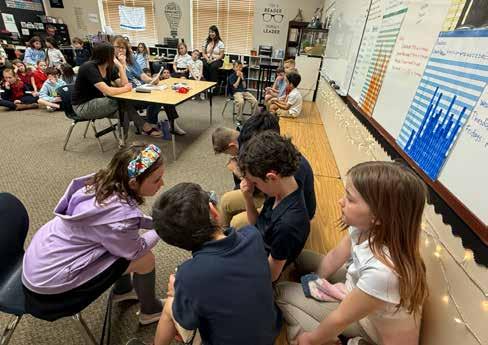
Hawthorn held 110 reading battles this year, expanding the program to include second and third grades.
Other winning teams included “Heart
of Souls” (second grade), “Dragon Legends” (fourth grade), “Book Readers” (fifth grade) and “Baddy Bops” (sixth grade).l

By Holly Curby hello@hollycurby.com
Whether it's the sizzle of hibachi flames, the comfort of pasta inside a vintage trolley, or sharing fondue by candlelight, the way we dine shapes our memories just as much as the food itself. In a world that increasingly values experience as much as flavor, eating out has become more than a necessity or luxury— it's a ritual of connection.
According to the National Restaurant Association, more than 60% of Americans dine out at least once a week, and 45% of adults say restaurants are essential to their lifestyle. From special occasions to everyday indulgences, here’s a roundup of my personal favorite local spots, categorized by the kind of meal and mood you might be in.
Sometimes, the best side dish is fresh air. When the weather’s kind, there’s nothing like dining al fresco:
• Trellis Café – My personal go-to for patio dining. Nestled among greenery, the ambiance is as fresh as the seasonal dishes. Ideal for a relaxed summer lunch, but be sure to make reservations and tell the amazing hostess, Jenn, I say hello.
• Cafe Molise – With an elegant courtyard downtown, it's perfect for Italian fare under the open sky. Try the penne di caprino and creme brulee.
• Silver Fork Lodge – Up Big Cottonwood Canyon, this spot offers rustic charm, a wooden deck and mountain air that makes everything taste better.
• The Terrace Cafe at St. Regis (Deer Valley) – Elegant, upscale and offering panoramic views, their patio is a destination in itself. Guests are transported up to the restaurant in the complimentary funicular which is an experience in itself.
• The Cliff Dining – True to its name, you’ll dine perched above scenic terrain. Great food and even better sunsets.
• Ruth’s Diner – Escape the city into the serene ambience of Emigration Canyon. Check out their website for a schedule of live music on the patio.
If you’re after a unique setting, these places deliver delicious food with a side of novelty:
• Spaghetti Factory – Where else can you enjoy classic spaghetti and meatballs while sitting inside an old trolley car? It's quirky, nostalgic and surprisingly cozy.
• Prairie Schooner – Steak and hearty American fare served in covered wagons under dim lantern light. A nod to Utah's pioneer past, this one’s both tasty and theatrical.
• Billy Buncos – A fun, funky place where you dine under cars suspended above you. The food? Equally creative and satisfying.
If your meal is also a game night or show, these places turn dining into entertainment:
• Good Move Café – Board games and bistro-style eats? Count me in. It’s the perfect spot for casual hangouts, family nights or a low-key first date.
• Benihana or Bonsai – Teppanyaki chefs cook right in front of you with flair and fire. It’s dinner and a show, seasoned with soy sauce and laughter.
• Desert Star Playhouse – Family-friendly musical parodies in a western-themed saloon. Get ready to cozy in with your neighbor as you share a pizza or enjoy a good old-fashioned root beer float.
Whether it's a taste of Israeli cuisine or a club sandwich, here are a couple more must-visits:
• Feldman’s Deli – A standout for East Coast-style deli fare with an Israeli twist. Their pastrami sandwich is legendary, and every entree ordered brings a much-anticipated bite.
• The Coffee Shop at Little America Hotel – Sure, it's the sister hotel to the luxurious downtown Grand America, but their club sandwich? Perfection. Pair it with a walk around the manicured grounds of their neighboring sister hotel for a surprisingly affordable treat in an upscale setting.

Dining out isn't just about convenience. It’s about atmosphere, ritual and the pleasure of sharing space with others—whether that’s with strangers gathered around a teppanyaki grill or loved ones sharing dessert under a starlit patio.
As Julia Child once said, “People who love to eat are always the best people.” And luckily, our local food scene is full of places that let you eat well—and live fully.
Want to learn more about how to up your dining at home experience? Check out Holly’s Highlights podcast Season 3 Episode 14. Available wherever you listen to podcasts. Have a favorite dining spot or want me to come visit your restaurant? Connect with me at www.hollycurby.com. l

Working in the food industry? Look to see if this certification is needed.
By Julie Slama j.slama@mycityjournals.com
aspiring of becoming a sous chef, planning to serve street tacos from a food truck or seeking a part-time restaurant job — one thing is almost always required first: a food handlers permit.
Many states, including Utah, require food service workers to complete food safety training before receiving their permit. This applies to those who prepare, serve or handle food for public consumption from restaurant staff and caterers to food truck operators and others whose roles involve direct contact with food.
In Utah, earning a food handlers permit means completing a 75-minute training course focused on food safety. The course teaches how to prevent food and surface contamination, use proper time and temperature controls to avoid foodborne illnesses, and maintain a clean and sanitary environment for food preparation and service, explained Cassandra Fairclough, program specialist at the Utah Department of Health and Human Services.
“It shows you understand the basics of food safety,” she said. “There are five or six things that are very concerning for food protection that can cause illness so those are some
of the things taught in the training classes, like handwashing hygiene, cross contamination in food, temperature control — holding at the right temperature for the correct amount of time and those factors.”
Another significant focus is proper chemical usage, said Jeff Oaks, food protection bureau manager for Salt Lake County’s health department.
“There's a component of dishwashing that has to be done,” he said. “You have to learn how you wash dishes in a restaurant because that's different than in your house with a triple sink and not a double sink.”
After the training, participants take a 40-question exam and must score at least 75% to pass. In Salt Lake County, those who pass will receive a temporary permit; the official Utah Food Handlers Permit will be mailed within 30 days. The permit is valid for three years. The course must be retaken for renewal.
Since 2013 the Utah Department of Health has approved third-party agencies to conduct the training, although local health departments can provide training as well and they are responsible for issuing the permits. From July 1, 2023 to June 30, 2024, Salt Lake County Health Department issued 41,240 of the state’s 109,865 food handlers permits.
To find a certified provider, visit the state’s approved training list: www.epi.utah.
gov/wp-content/uploads/foodHandler_list.pdf. Providers may offer in-person or online options, sometimes in multiple languages. Check to ensure the online courses are compatible with all devices and operating systems.
The base cost of the training is $15, though agencies may include additional processing or administrative fees. In some cases, employers may cover the cost or offer group discounts.
Additional licenses, permits or certifications may be required for specific roles — such as serving alcohol, being a food manager, running a food truck or operating a booth at a farmers market.
“Different agencies will have requirements,” Oaks said. “In Salt Lake County, all restaurant workers have a food handlers permit, but for example, there are companies that package produce locally, like a bag of carrots or lettuce, and they are regulated by the state’s agriculture and food department. But within their facilities, they require food handlers permits or some other certification. Some companies may say, we still want you to get a food handlers permit. We have almost 5,500 restaurants (and others that serve food) so all their employees either have managers’ certificates or food handlers permits. Usually, the grocery store employees have food handlers permits if they're working in the deli or the butcher shop
or the produce, where they're cutting and doing food preparation and established concessioners such as the (University of Utah) Utes or Utah Jazz have food handlers permits.”
“It’s best to check with your local health department to get specific conditions and information on the type of food service that is being provided so they can help people learn what is required,” Fairclough said.
She said the food handlers training and certification program is regularly reviewed by state officials, local health departments and industry professionals to ensure it aligns with the latest (2022) version of the FDA Food Code, along with Utah-specific amendments. The Food Code is designed to protect public health and provide a standardized approach to food safety across various service environments.
Oaks, who has taught food handlers permit classes, said he had parents who would bring their kids to get a food handlers permit.
“It’s good knowledge and they wanted their kids to know; it had nothing to do with employment,” he said. “If you want to up your game for food safety, food preparation or food serving at home or wherever you might be, it's not a bad idea to get it. Not all states require a food handlers permit, but I’m glad Utah does. I'm glad our legislature and our state health department see the value in it, so there's at least a minimum standard for food workers.” l






























At Granite Credit Union, we know saving can be a challenge, especially when you’re young. That’s why we’re excited to introduce the YoungInvestor Savings Account – available exclusively for members aged 0-26 to help you expedite your savings goals. See how quickly your rounded up change adds up! From now until September 30th, 2025, Granite Credit Union will match your Round-Up deposits up to $50.
Round-Up Option
|
Teens dig into hands-on learning experiences with local plant and animal agriculture.
By Jet Burnham j.burnham@mycityjournals.com
FutureFarmers of America summer agriculture students not only understand where their food comes from, but they are actively involved in the process. Their summer has been spent growing their own food, raising livestock for auction, engaging with animals in the community and touring local agricultural sites.
“They choose their project and then we are just there to help them develop goals and help them improve through their project,” Jordan Academy of Technology and Careers agriculture instructor Sydnee Roholt said.
One of the most popular summer programs is raising sheep, goats and pigs to show and sell at the Salt Lake County Junior Livestock Show and auction taking place Aug. 6-9 at the Bastian Agricultural Center in South Jordan.
Miley Berg, a senior at Bingham High School, said the hands-on experience of caring for a lamb this summer has been good preparation for her future career as a veterinarian. She has learned what her lamb Eloise likes, where she prefers to be rubbed and how to calm her down.
Riverton High School junior Rachel Baggaley was excited for the chance to raise a lamb even though she knows it will be slaughtered for food.
“I eat meat and I understand and know where it comes from,” Baggaley said. “I know at least that she got someone that loved her, so I thought that it’d be better than her just not being

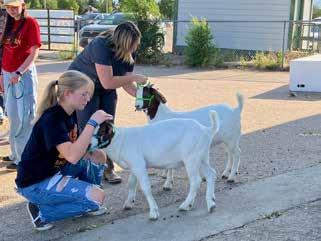
cared about.”
Students become attached to their animals because they visit them every day all summer to feed, groom and train them. Jameson Evans became quite attached to his sickly goat last year as he nursed him back to health before he was donated to the food bank.
“I was happy that he was going to a family who needed him the most, and that’s what really gets me through this, that they’re going to the family that really needs the food,” he said.
Although Evans graduated from high school this year, he jumped at the chance to participate in the summer ag program one last time.
“I did it last year and it was super fun—it was the best summer of my life,” Evans said. “It brought me into an industry that I am passionate for, and I got another opportunity to do it even after I graduate so I was going to take the opportunity. It is honestly a life changing experience that I wouldn’t trade for the world.”
He plans to get an agricultural teaching degree and to someday breed livestock for 4H clubs to help kids learn about where their food comes from.
“Most kids are sitting in their basements playing Minecraft or Fortnite and they don’t really understand,” he said. “And so getting them out and about and learning about what it takes shows them there’s a lot more that goes into it than just going to the grocery store and picking it up.”
Some students earned their summer ag class credits for a variety of experiences at the zoo, conservation gardens and tractor shows. Others counted the hours they worked at a doggy daycare or veterinary clinic. Many students’ projects centered on work they did at home, such as one student who raised meal-
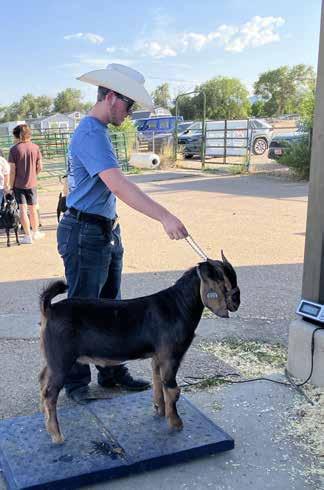
worms to feed his family’s chickens.
“I have never seen a kid so proud of bugs,” Riverton High School agriculture teacher Kaylee Simpers said.
Sarah Atkinson, a senior at Riverton High School, helped grow more than 15 kinds of vegetables in her family’s quarter-acre garden and three kinds of fruit in their orchard. This fall, she will be canning the fruits of her labors.
“I’ve been gardening with my mom since before I could remember, and it’s been in my family for generations,” Atkinson said.
Her love of gardening led Atkinson to take science and agricultural science classes at school. She learned about threats to the environment and agriculture industry and has been inspired to find solutions. Her FFA Agriscience Fair project, a proposed solution for preserving soil for irrigated barrier crops, took first place at state and qualified for the national fair in Indianapolis this November.
Atkinson plans to make a difference in the agriculture industry by studying biological engineering in college, but she believes everyone should be educated about how the food they eat is produced so they can make more environmentally-sustainable and ethical decisions about what products they buy.
“Where you get your food from really does matter, and there are some places that you get your food from that are actually really horrible,” Atkinson said. “There are countless food items that you see every single day at your grocery store that use child labor, or slash and burn agriculture or horrible amounts of herbicides and pesticides with no regard for the environment. So just being more aware of what foods are good and what foods are bad for the environment could really help make a change.”l

Three Miners make All-State teams, but all eight seniors had their moments on this state runner-up.
By Brian Shaw b.shaw@mycityjournals.com
When things were looking kind of bleak for the Bingham Miners softball team early in the season, Gracelyn Lemke called a special team meeting.
The Bingham senior told the girls that it was time they started playing for each other. Lemke said these Miners needed to start having fun playing the game they fell in love with as kids.
Eventually, that about-face turned things around for the team, and the Miners never looked back until theat 6A Championship Game, where they fell in anthat unfortunate Game 3 loss to rival Riverton in a narrow 10-7 decision.
Key to that turnaround?
The core of a group that captured a state title as sophomores and reached the state championship game two years in a row after that, ending their time at Bingham this past May as some of the program’s modern-day greats.
Eight seniors. Six college commits in total. Of those playing their last softball for the Miners, three made All-State teams.
Brooklynn Fogg was a terror on the base paths. Headed to SLCC, the senior speedster finished with a .955 fielding percentage this season, the best of her career.
“Brooklynn wrapped up an incredible season, and we couldn’t be more proud of the player - and person - she’s become. Her senior year was more than just a final chapter; it was the result of years of dedication, growth, and perseverance through every high and low along the way,” said her father, Bobby Fogg, said. “She gave it everything she had, and it showed. Of course, she didn’t get here alone. We’re deeply grateful for the coaches who believed in

her and the teammates who pushed her to be her best. It’s been a journey, and we’re so thankful to everyone who’s been part of it.”
BrooklynnFogg hit .415, had four doubles and 11 RBI, and even hit her first home run as a senior. Fogg also stole nine bases and completed her career with 36 stolen bases, along with 83 hits and a three-year batting average of .329. That earned Fogg 6A Second Team All-State honors, the first time in her career she’s achieved such an honor—Fogg was named Honorable Mention last year.
Brecka Larson firmly etched her name in the school’s record books by throwing 222 strikeouts this season. The SLCC-bound senior finished with a 37-19 record as a Bingham pitcher. Her 517 career strikeouts ranks first among modern-day Miners that played from 2011 to 2025. For
her efforts on the circle, Larson was named 6A First Team All-State. She also hit 35 RBI this season, ninth best in modern-day school history and finished her time as a Bingham hitter with 11 home runs, 70 RBI and hit three triples and nine doubles.
And then there was Shyann Banasky. Like Fogg, the senior never made an AllState Second Team—let alone a First Team. Her best season was last season, and that earned Banasky an Honorable Mention. This year, however, there was no turning back for the senior bound for the College of Southern Idaho, as she made the 6A All-State First Team.
“I’m really excited she went out on a bang,” said her mother, Shauntel Banasky, said. “She had her best season, she played phenomenally. Her bunt coverage from third base was unmatched. I’ve never seen anyone intentionally walked all four at
bats at a game ever, that was a core memory for me.”
Banasky made a lot of memories for this Miners team as a senior. She led Bingham in batting average, hitting .494. Banasky also topped the Miners in onbase percentage (.612), hits (44) and RBI (42). She was also the top Bingham hitter in slugging percentage (.910) by almost 300 points, and doubles (14) and triples, with four on the season. Above everything though, her mom was impressed by her hard work and determination to improve off the field.
“She had a full mindset change and it was incredible to see the growth,” said Shauntel Banasky’s mom said.
The Miners’ other five seniors included Gracelyn Lemke. The Bingham senior hit a team-high seven home runs and was second on the Miners in slugging percentage, at .630 for the season. A four-year starter, Lemke had a .367 batting average in almost 300 at-bats, hit 16 home runs, had 95 RBI and stole 17 bases over her career.
Another senior who played a big role in the Miners success was Rian Howland. Bound for Snow College, she ranked first in fielding percentage (.976) on the Miners this season and ranked in the top three in five other categories (OBP, RBI, slugging percentage, doubles and triples). For her career, Howland hit .401 for the Miners— including .480 as a junior. She also had a .975 fielding percentage in four years at the school.
The sixth senior bound for college is Zalia Carrillo. Headed for Dawson (Montana) College, this Miner hit .309 over four years, along with 32 RBI. Other seniors for the Miners were Kamrie Cowley, who hit .333 as a senior and Makalia Wooton, who smacked three RBI in four at bats this season. l







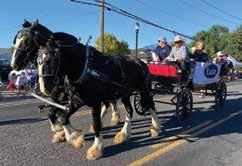




Larkin Mortuary’s dedication to the Utah community is deeply rooted in its history and family values. For over 140 years, spanning seven generations, the Larkin family has proudly served Utah families in their time of need. This commitment extends beyond providing funeral services; Larkin Mortuary actively engages with the community by hosting events and giving back through various service initiatives such as the annual Memorial Day Program, golf tournament, Trunk or Treat and Live Nativity.
Misconceptions about the cost of locally-produced food keep some families from enjoying the benefits.
By Peri Kinder peri.k@thecityjournals.com
Local farmers markets are welcome events, recognized for delivering fresh, seasonal produce and food items. But for some families, the price of farm-fresh products seems to be too high, creating a nutritional divide for lower-income households.
Natalie Loots wants to change that narrative. She is the Community Food Security Program manager with the Utah Department of Health and Human Services and said there are several programs available to make farmers markets accessible and affordable.
“Our main goal is to make local foods, like fruits and vegetables and other high-nutrition foods more affordable for low-income folks,” Loots said. “Our main program that we operate is called the Double Up Food Bucks program, which has been around since 2015.”
With Double Up Food Bucks, people enrolled in the SNAP program can get up to $20 of free Utah-grown produce with every visit to a participating market. The program offers a dollar-for-dollar match, up to $20, matching SNAP benefits.

“If folks go to the information booth at the farmers market, they swipe their SNAP card and they’ll get tokens for SNAP and then tokens for Double Up to use at the different vendors at the market. There’s no paperwork they need to fill out. All they have to do is have a valid SNAP card that is currently active.”
Loots said the CFSP works to eliminate barriers that limit access to nutrition-
ally-dense foods. Initiatives like the Senior Farmers Market Nutrition Program offers low-income seniors a $50 farmers market voucher to use throughout the season. Utah Produce Rx partners with local healthcare clinics to create a $300 fruit and vegetable prescription patients can use at participating farmers markets.
Caroline Hargraves serves as the marketing director for the Utah Department of

Agriculture and Food’s economic development division. She said while prices might be higher on some items at farmers markets, the food quality and nutritional value is much better than what can be found in many grocery stores.
“I think a lot of people don’t understand that it takes time, energy and labor to produce food. We have such a culture in America of expecting food to be cheap but people who produce it deserve a living wage,” Hargraves said. “Farmers get such a small portion of the dollar that the average consumer pays at the grocery store and I think people don’t understand that. But when you buy directly from farmers at a farmers market, that money is going directly to them.”
Utah’s DHHS operates a local food purchasing assistance program to help socially disadvantaged farm owners. Since the spring of 2022, the program has purchased food from local farmers to distribute to families experiencing food insecurity.
More than 60,000 individuals have received farm fresh food at nearly 600 distribution events across the state. This will be the last summer the program will be utilized, as federal funding has been cut, but organizers are looking for additional funding sources.
A 2025 Utah State University study, Cultivating Community and Commerce: A Summary of the Statewide Social and Economic Impacts of Utah Farmers Markets, found that farmers markets offer more than just fresh produce. Communities hosting farmers markets fostered community connection, empowered small businesses and contributed to the state’s economy.
The study also found food deserts are prevalent in the state. These areas have limited access to nutritious food, affecting more than 800,000 Utah residents. Farmers markets address this dire need, so affordability is key.
“We have several initiatives at the Department of Agriculture and Food to encourage people to support local farmers and ranchers,” Hargraves said. “It does make a difference, both for that individual, like a farmer or business owner, and for the community. The more dollars we can keep circulating in our local economy, the better. But also it tastes better. With local foods, you can taste the difference.”
For more information about farmers markets affordability programs, or to find participating markets, visit uah.org/get-help.
“Our work is aiming to make food security accessible in a way that it functions as a social determinant of health,” Loots said. “Farmers markets are for everybody, and we try to make eating local produce accessible to everybody…Access to healthy foods affects chronic disease outcomes or health outcomes, longevity and quality of life. Those are so deeply connected.” l
More than 250 trucks serve up vibrant menu items at thousands of events each year.
By Peri Kinder peri.k@thecityjournals.com
It’s been 10 years since the Food Truck League held its first event at Sugarmont Plaza in Salt Lake County. Organizers didn’t know what to expect but figured they’d be lucky to get 500 people to attend. When 2,000 people showed up, Food Truck League Founder Taylor Harris realized he might be on to something.
A decade later, food trucks have transformed Utah’s culinary landscape, introducing cultural fare, fusion meals and unique twists on old favorites. More than 250 food trucks are registered with the Food Truck League in Utah, each serving vibrant, bold and palate-pleasing menu items at approximately 10,000 events an nually.
“As far as small companies coming up, Utah is an entrepreneur-friendly place,” said Eliot Steimle, Food Truck League gen eral manager. “For anyone who wants to get into a restaurant, a food truck is a nice half-step in that direction, where they can get experience, find something they can ex periment with and build a following.”
Food trucks like Cupbop, Waffle Love and Salt Lake Barbecue have taken their menus into brick-and-mortar locations or food halls where they can expand their cus tomer base. Other chefs like the ability to travel across the county, sharing their food with new communities.
Successful members of the Food Truck League utilize savvy marketing strategies and leverage social media platforms to cul tivate loyal fans. Whether it’s behind-thescenes content, interactive videos, daily location updates, tailored hashtags, curated photos or exclusive items sold only at spe cific events, creative brand-building is an important part of a food truck’s story.
“It’s fun to watch them come into their own,” Steimle said. “Most of the time, it’s a chef who starts their food truck, but that marketing element of trying to figure out what their brand is and their identity, that part is really fun.”
As the state’s food truck industry evolved, catering everything from office lunches and corporate events to weddings and concerts, chefs have learned that flex ibility and collaboration are some of their best tools. Being able to adapt to weather conditions, listening to customer feedback and pivoting when needed can help a food truck owner stand the test of time.
Legislation and permitting for food trucks have also improved over the last few years. When food trucks first appeared on the scene, every city had different regula
tions and licensing requirements that owners had to deal with. Often, food trucks had to obtain health permits, fire inspections and business licenses for each city they visited.
“Two or three years ago, the state legislature passed a bill that essentially got rid of all of the secondary permits and licenses,” Steimle said. “That was a huge game changer for the food trucks.”
Not only do food trucks introduce new foods to residents, but food truck events bring the community together, turning parking lots into social gatherings and encouraging inclusion through global flavors. Mexican foods, pizza and barbecue seem to be the most requested trucks, but Hawaiian fare, dessert and breakfast items are also popular.
Several cities host food truck nights and Midvale recently opened a plaza built for food trucks next to City Hall. The idea




Lena Casperson, Iman Finau and Raylynn Richardson first Miners to sign, coach expects at least one more to follow.
By Brian Shaw b.shaw@mycityjournals.com
With colleges looking to ink high school student-athletes during this signing period, the Bingham Miners girls’ basketball team has been fortunate to have had some of its recently graduated seniors commit to colleges.
Raylynn Richardson was the first Miner to be announced by Bingham on April 19. She will play and study at Treasure Valley Community College in Ontario, Oregon.
“Richardson did an amazing job rehabilitating her knee and we asked her to play a few different positions,” Bingham head coach Hector Marquez said of his 5-foot-10-inch senior.
Richardson played in 25 games, shooting 46% from the field, second-best on the team. For Marquez, Richardson’s versatility was a key factor for one college, in particular.
“Her (new) coach spoke with me a few times and was excited about her size and ability to play a few different positions,” Marquez said. “Ray has a lot of upside and should continue to get better over the next few years.”
Then on May 19, Lena Casperson was the next college commitment; the 5-foot-10 senior will continue her studies and play basketball at Big Bend Community College in Moses Lake, Washington.
“Lena was a hybrid wing/small forward for us and she improved her game so much that teams tried to game plan against her,” Marquez said.
Casperson averaged about 10 points per game and five rebounds for the Miners, and led the team in shooting at 51%.
“Her willingness to play all over the floor really helped her get next level offers,” explained Bingham’s coach. “Casperson had offers from a few colleges and we are excited to see what she can do at the next level.”
Iman Finau rounded out the college commits from Bingham on June 17; she will be playing and studying at Umpqua Community College in Roseburg, Oregon.
“I am so happy for Iman to get the opportunity to play at the next level,” Marquez said. “With more than a handful of schools from all over the country trying to convince her to come to play for them she decided to stay in the West.”
Finau set a school record with 47 blocks in one season as a Bingham senior and hauled down 143 rebounds, both team-bests. The 5-foot-9-inch multi-sport athlete also was second on the Miners in assists and steals.

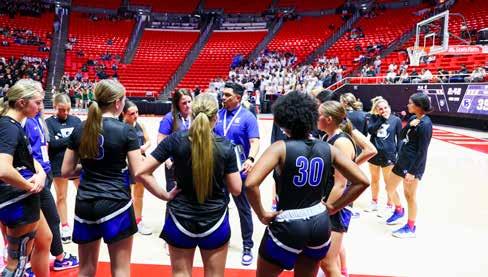
“Iman was one of the best athletes in the state and she had offers to play volleyball as well,” explained Bingham’s girls basketball coach. “She will be able to play her true position as a guard at the next level but her versatile play on defense will allow her to defend multiple positions and her coach is excited about that.”
Marquez said he expects at least one more college commitment in the weeks to come— one with dozens of schools showing interest.
This individual led the Miners in points, assists and steals—and was third in rebounds despite only being 5-feet-6-inches tall.
“We will likely have one more player make her decision on where she will attend as she has had over 40 schools reach out trying to bring her aboard.
Addy Horsley has heard from Division 1 all the way down to Division 3 schools. She is going to be an amazing addition to whatever program she chooses.” l


























Funeral arrangements are a deeply personal choice. Preplanning provides you with the time needed to make practical, detailed decisions that reflect your standards, lifestyle, taste and budget. And we assure you and your family that the choices you make will be carried out as planned.







By Becky Ginos becky.g@thecityjournals.com
been 65 years since Max Elliott started his career in the Davis County Surveyor’s Office and he’s still going strong. Elliott was just reelected as Davis County Surveyor for another three years – so retirement is in the distance.
“Surveying is kind of a unique line of work,” said Elliott. “You’re more outside than inside.”
It was more or less luck that brought him into the field, he said. “I worked under Don Davis then worked under Glenn Austin. When he retired I served the remainder of his term.”
Elliott served as the elected surveyor for eight terms and in 2021 started his ninth term. During that time he had only one challenger for his position.
“If there was an election and they found out he was running nobody was willing to run against him,” said Administrative Secretary Louise Miller. “Everybody respects him. He knows everything about Davis County. If you ask a question he’ll know where to find the material.”
Max is wonderful to work for, she said. “He lets us do our job but he’s there if needed. I’ll be working on something and he'll ask if I need to sit down or suggest I need time off. He cares about us.”
He treats everyone with respect and kind-


ness, Miller said. “If the public comes in and needs something he’ll give the answer but if he doesn’t know the answer he’ll search until he finds it.”
“I have known and worked with Max for many years,” said Chief Deputy Surveyor, Kyle M. Corbridge. “One day we were surveying in an open field and we were using a 300 foot metal chain to measure distances with. Max took the front end of this metal tape and I held onto the rear end of the chain.”
Corbridge said Max went out about 295 feet from him to set a point in the ground. “I was standing next to an electrical fence the farmer had to keep his livestock in. I was holding onto the reel of this tape secured onto a wooden handle. I somehow ‘accidentally’ made contact with this fence and about 300 feet away I heard a commotion. It took some time before he was able to laugh about that.”
“I’ve seen a lot of changes in 65 years,” said Elliott. “I used to work with steel tapes that were 300 feet long. Now we’ve got global system positioning. It can tell within a dime in an area if it’s done right.”
There’s satisfaction in keeping the real map (which is the earth itself) in place, said Elliott. “It’s quite a job keeping those points in place with all of the growth.”
Elliott said surveyors are concerned that in a few years there won’t be enough people interested in the field to follow in their footsteps.






“Most surveyors are in their 50s, 60s or 70s. I know if they got involved in doing it they’d be excited to come into the profession. I don’t think you can meet anyone who would say they don’t enjoy it.”
“I know him as a man of integrity,” said Corbridge. “As a surveyor he is thorough, en-


suring the work is being done in an accurate and precise manner. He has been a great leader, teacher and mentor through his examples and patience.”
“I thoroughly enjoy this profession,” said Elliott. “I got into it and stayed.” l


Have you ever wondered what Salt Lake County actually does? If you live in one of the 23 cities in our area—like Murray, West Valley, South Jordan or Millcreek—you might think the county doesn’t affect your daily life. But the truth is, Salt Lake County helps all of us in big and important ways. Everyone who lives in the Salt Lake Valley is part of Salt Lake County.
Salt Lake County is like the glue that holds many parts of our community together. While cities take care of things like neighborhood parks and snow plowing on local streets, the county provides services that work best when shared by everyone. These regional services save money and help us all live better.
What Services Does Salt Lake County Provide?
Let’s break it down. Salt Lake County helps in areas like:
- Public Safety and Criminal Justice: The county runs the jail, provides prosecutors and public defenders, and helps with emergency response. In fact, public safety is the county’s biggest responsibility—it makes up over 74% of the county’s general fund.
- Elections: The county clerk makes

Salt Lake County Councilmember|
District 3

sure elections are fair and secure. Cities contract with the county clerk for their municipal elections.
- Health Department: The county helps keep our community healthy by inspecting restaurants, giving vaccines, and cleaning up unsafe places like abandoned camps.
- Senior Services: Through programs like Meals on Wheels and senior centers, the county helps older adults stay active and connected.
- Mental Health and Addiction: The county leads programs for people who need support with mental illness or substance abuse, partnering with other groups to reach more people.
- Libraries: The Salt Lake County Library system serves most of the area (Mur-
ray and Salt Lake City have their own), giving people access to books, computers and classes.
- Parks and Recreation: From big parks and trails to swimming pools and rec centers, the county helps families stay active both indoors and outdoors.
- Arts and Tourism: The county owns facilities like Abravanel Hall and the Capitol Theatre, and brings in out-of-state visitors through conventions and tourism, which boosts our economy. The county owns the Salt Palace and Mountain America Expo Center.
- Property Tax and Land Records: The county collects property taxes (even for cities and schools) and keeps track of land ownership and real estate records.
A Government That’s Smart With Your Money
Salt Lake County has a budget of about $2 billion. While that sounds like a lot, only part of it is under the County Council’s full control. About $500 million of the total budget is what we call “passthrough” taxes—meaning the county collects it and passes it to others, like UTA or cities.
To stay financially strong, the Salt Lake County Council keeps a close eye on
spending. They’ve helped the county keep a AAA bond rating—the highest possible score, showing the county is careful with its money. The council also does stress tests and checks each department regularly to look for savings and to improve services.
Utah law doesn’t let counties collect more money just because home values rise. Instead, counties can only collect more if there’s new growth, like a new building. That keeps taxes fair, but it also means the council has to plan ahead and budget wisely.
One County. Many Communities. One Mission.
Salt Lake County doesn’t replace cities—it supports them. Whether your city needs help with road signs, snow removal or mapping, the county can step in with expertise and resources. It’s about teamwork.
The county’s job is to serve, support and strengthen every community in the region. By managing big services, using your tax dollars wisely, and working across city borders, Salt Lake County makes life better for all of us.
So next time you vote, enjoy a park, visit the library, or call for help—remember, Salt Lake County is there for you. l

















There was no “gentle parenting” in the ’70s, especially at the dinner table. You either ate what was prepared for you, or you were labeled a sniveling, spoiled brat who didn’t care if children in China starved because you wouldn’t eat your meatloaf.
One time, I was forced to stay at the table until I’d eaten all my potatoes. I blame my dad. He had told me that potatoes have eyes and then lost his mind when I refused to eat mashed potatoes. I was convinced the lumps were eyeballs and I was not about to eat potato eyeballs.
I wasn’t trying to be picky, I just didn’t like things that were mushy, smelly, runny, squishy, eggy or slathered in mayo.
Grandma Stewart considered me the most coddled child in history. She could not fathom how I could reject her slimy bowl of lima beans, which included (if memory serves) onions, ham, shampoo and arsenic.
“If you don’t eat your lima beans, it just means you're spoiled,” she huffed when I put my head on the table to cry. She said the same thing when I refused to eat bread crust, cottage cheese, tuna fish or canned beets.
Side note: Grandma loved Jordan almonds, the only food she refused to share. She’d hide them from the grandkids because she knew we’d eat them. We scoured the cabinets until we found them and devoured every last one. I think that’s called a self-ful-
Peri Kinder Life and Laughter

filling prophecy, Grandma.
As a kid, terrible food was everywhere. If I wasn’t being subjected to a disgusting recipe Mom found in a McCall’s magazine, I was being betrayed by school lunch ladies. They’d slide a quivering square of delicious cherry Jell-O, topped with whipped cream, onto my lunch tray. But the joke was on me when I took a big bite of the tasty dessert only to learn it was sour cream, not whipped cream. Who does that to a child? Sadists, that’s who!
While eating dinner at a friend’s house, her mom shamed me for not eating the disgusting canned peas. So, I ate it and cried. It was just another meal I was forced to eat, like a hostage.
Sometimes, I’d take a proactive approach when it came to avoiding foods I didn’t like. Mom often made chicken pockets, which were shredded chicken mixed with cream cheese, baked into crescent roll dough. I hated cream cheese (mushy,


smelly). When I saw it in the fridge, I cried. I hid the box of cream cheese behind the wilted lettuce in the vegetable bin, but Mom always found it.
Other ploys included acting sick (rarely worked), “forgetting” about dinner while playing outside (never worked), pretending to sleep on the couch (sometimes worked) and throwing a fit at the dinner table (never worked, plus I lost dessert).
I don’t know why Mom refused to accommodate my delicate palate. I was only repulsed when it came to sauces, dressings, mustard, canned foods, Vienna sausages, tuna, cottage cheese, sour cream, maple syr-







up, vegetables, macaroni salad, yogurt, the textured vegetable protein popular in the ’70s or anything slathered in mayo.
It didn’t matter. I was expected to “Learn to like it, or else!” Or else, what? A grateful digestive system? A lack of nightmares? A healthy relationship to food? With four daughters, I understand how hard it is to make meals for ungrateful children. I’ve had daughters who refused to eat pizza, spaghetti, meat, dairy products, lasagna, hamburger casserole or anything with onions. They probably have their own list of foods that ruined their childhood. That’s what therapists are for. l






